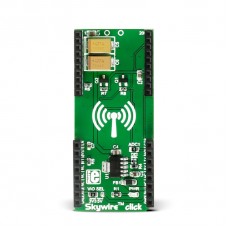Next Skywire click
Skywire™ click is an adapter click, which hosts NimbeLink/Skywire™ cellular modems (using stacking headers) to MikroElektronika development boards. It carries the MCP1826 low dropout regulator from Microchip. Skywire™ click is designed to run either on 3.3V or 5V power supply. The click communicates with the target MCU over UART interface, and the following mikroBUS™ pins: PWM, AN, INT, RST, CS.
NOTE: the Skywire™ modem and the Thermo 3 click are not included in this offer.
Additional mikroBUS™ socket
Skywire™ click has the capability to host an additional mini sized click board™. It also has its own power supply to make the needed voltage for the modules.
Skywire cellular modems
Skywire™ cellular modems are the smallest on the market today. This product family from NimbeLink covers everything from 2G and 3G to LTE. They all share the same footprint and pinout, and are flexible for implementation.
Specifications
| Type | Adapter |
| On-board modules | MCP1826 LDO regulator |
| Key Features | Additional socket for mini sized click board™, MCP1826 LDO regulator, 3.3V or 5V power supply |
| Key Benefits | Adapts Nimbelink/Skywire modules with MikroElektronika development systems |
| Interface | UART,GPIO |
| Input Voltage | 3.3V or 5V |
| Compatibility | mikroBUS |
| Click board size | L (57.15 x 25.4 mm) |
Pinout diagram
This table shows how the pinout on Skywire click corresponds to the pinout on the mikroBUS™ socket (the latter shown in the two middle columns).
Jumpers and settings
The following table describes the functions of the onboard jumpers.
| Designator | Name | Default Position | Default Option | Description |
|---|---|---|---|---|
| JP1 | PWR.SEL. | Left | 3.3V | Power Supply Voltage Selection 3.3V/5V, left position 3.3V, center position 5V |
| ADC1 | ADC1 | Populated | 3.3V | Connects ADC1 pin of the modem to the mikroBUS pin |
Programming
Code examples for Skywire click, written for MikroElektronika hardware and compilers are available on Libstock.
Code snippet
The following code snippet starts the main function in the Skywire application.
This is a simple main function, which excepts a call and replies with an SMS to caller. The content of the SMS is the current temperature measurement in degrees Celsius.
01: void main()
02: {
03: measure_f = false;
04: system_init();
05: skywire_power_on();
06: at_init( rsp_handler, UART3_Write, buffer, sizeof( buffer ) );
07: at_cmd_save( "+CLCC", 1000, NULL, NULL, NULL, callerid_handler ); // Assigning caller ID handler
08: at_cmd_single( "AT" );
09: at_cmd_single( "AT+CSCS="GSM"" );
10: at_cmd_single( "AT+CMGF=1" );
11: while( 1 )
12: {
13: at_process();
14:
15: if( measure_f )
16: {
17: measure_temp();
18: at_cmd_single( "AT+CLCC" );
19: at_cmd_single( "ATH" );
20: Delay_ms( 2000 ); // Delay needed after ATH
21: reply_to_caller();
22: measure_f = false;
23: }
24: }
25: }
Downloads
mikroBUS™ Standard specificationEnter the code in the box below:









